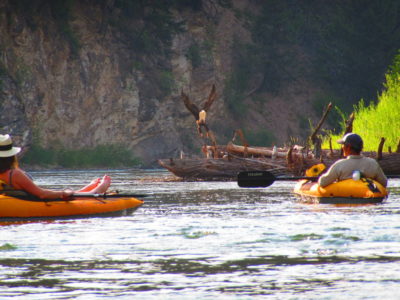By Karen Laitala, Vegetation Coordinator
Although anyone who knows me knows that I’m a “certifiable” botany and native plants nerd, I love everything nature. In particular, I share a love of birds with one of my sisters. On a trip together one October, we went to a wild bird rescue facility (Vermont Institute of Natural Science) to attend one program, and ended up staying all day, much to our mutual delight. We often send each other articles, pictures, and messages about birds back and forth from our homes in Montana and Massachusetts.
Recently my sister sent me an article titled, “Scientists Finally Identify a Deadly Toxin That’s Been Killing Birds.” As I dove into the journal article, I was surprised to discover that the culprit has been traced back to a previously unknown cyanobacteria produced on the leaves of the invasive aquatic plant hydrilla. As many of us are aware, cyanobacteria, also called blue-green algae, are known for creating potentially toxic blooms that affect waterbodies across Montana, including in the nearby Nevada Creek watershed. While not all varieties are harmful, some can produce dangerous cyanotoxins that are harmful to people and pets.

For more than 25 years, the cause of death of thousands of eagles and other birds across the Southern United States remained a mystery. When 17 bald eagles died on a reservoir that happened to be the site of a scientist’s research project, she noticed that while years earlier the lake had been largely vegetation free, it was now overtaken by hydrilla. Susan Wild, a professor of aquatic science at the University of Georgia, began to wonder if the eagle deaths were related to the new plant’s presence and started investigating.
Wilde and an international team of researchers from Germany, the Czech Republic and the United States discovered that the toxin produced on the leaves of hydrilla was then eaten by herbivorous birds which once poisoned became easy prey to bald eagles who were in turn poisoned. Of concern, as well, is whether or not humans that consume infected waterfowl can be affected. Robert Sargent, a program manager for the Georgia Department of Natural Resources points out that while the eagle deaths are alarming, they indicate a much larger problem. “Whenever we see illnesses or deaths of species at the top of the food chain, it’s a red flag for the potential health of the environment”, he stated.

It is thought that hydrilla was initially released in the US in the 1950’s when the popular aquarium plant was dumped into a Florida waterway. Since that time, hydrilla has become one of the most destructive freshwater aquatic weeds in the country, from lakes in Washington to Wisconsin to the Carolinas.
Watercraft Inspection Stations began opening this month across Montana. A boat heavily infested with zebra mussels stopped at Anaconda was the third mussel-fouled watercraft intercepted in Montana this year. State Fish, Wildlife, & Parks officials have identified inspection stations as the first line of defense in preventing the movement of all types of aquatic invasive species and the huge negative impacts these exotics can have on Montana waterways. Invasive mussels were also found in aquarium plant “moss” balls imported from Ukraine and distributed to pet stores in Montana in early March of this year. FWP officials are urging that tank water not be emptied into other water sources, including down the drain, as larval bodies that are not visible to the naked eye could be present in the water.
We as residents play an important role in efforts to control aquatic invasive species. Pet, fish, water garden and pond owners should never release aquatic plants or animals into the wild, or purchase prohibited species. Boaters, hunters, anglers, scuba divers and snorkelers, sea plane operators, and other recreationalists can protect Montana waters by following Clean Drain Dry laws. Remove visible organisms attached to or in recreational equipment (with hot water if available) and dispose of mud and vegetation away from water; drain compartments that hold water and remove plugs; dry equipment thoroughly. And, if you see oddly behaving or unusual numbers of deceased aquatic birds or birds of prey, report those sightings to our state wildlife agency.
